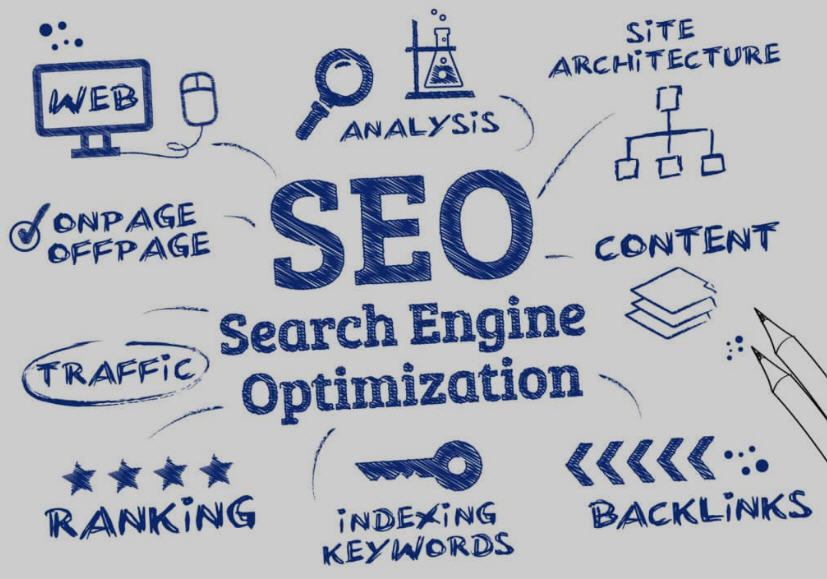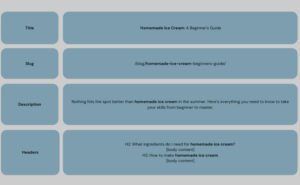
Why SEO?
SEO means Search Engine Optimization and is the process used to optimize a website’s technical configuration, content relevance and link popularity so its pages can become easily findable, more relevant and popular towards user search queries, and as a consequence, search engines rank them better.
- Understand your online customers. …
- Use keywords on your website. …
- Update your content regularly. …
- Gain referrals from other websites. …
- Use meta tags in your content. …
- Stay up to date on the latest SEO techniques.
Search engine optimization (SEO) is the art and science of getting pages to rank higher in search engines such as Google. Because search is one of the main ways in which people discover content online, ranking higher in search engines can lead to an increase in traffic to a website.

The most common example of on-page SEO is optimizing a piece of content to a specific keyword. For example, if you’re publishing a blog post about making your own ice cream, your keyword might be “homemade ice cream.” You’d include that keyword in your post’s title, slug, meta description, headers, and body.
Good SEO vs. Ad Cost
The Core Concept:
Organic Traffic vs. Paid Traffic: SEO helps you rank high in search results organically (without paying for every click). Paid ads put you at the top, but each click comes at a cost. Good SEO means more people find your website naturally.
Relatable Examples:
The Home Repair Search Someone’s faucet is leaking – they need a plumber fast! They search “emergency plumber near me.”
- Poor SEO: Your plumbing business doesn’t show up on the first page of results. You rely on ads, which means every person who clicks might cost you money, even if they don’t end up hiring you.
- Good SEO: You rank at the top organically. People find you immediately, trust your expertise, and you only pay if they click on an ad as a secondary option.
Finding the Perfect Outfit A fashion blogger writes a popular article about “must-have summer dresses.” Your online store has a dress that fits the description.
- Poor SEO: Your product page is buried. You run ads to try to appear in relevant searches, but it’s a constant battle against competitors’ ads.
- Good SEO: The blogger links to your dress because your product page is optimized, making it super relevant to the search. You gain targeted traffic without paying for ads.
The Curious Researcher Someone wants to learn about cryptocurrency investment. You create in-depth articles and resources on the topic.
- Poor SEO: Your content is valuable but gets lost in the crowd. You might advertise to get initial traffic, but it’s a short-term solution.
- Good SEO: Your content ranks well for relevant searches. People looking for trustworthy information find you easily, building your reputation without constant ad spending.
Key Takeaways:
- SEO is an investment: It takes time and effort, but the payoff is long-term, sustainable traffic.
- Reduced Reliance on Ads: Strong SEO doesn’t mean you quit ads entirely, but it gives you more control over your budget.
- Brand Awareness Boost: Ranking well organically builds trust and positions you as an authority in your niche.
Different branches of SEO
- Focus: Optimizing elements directly on your website’s pages.
- Includes:
- Keyword research and targeting
- Title tag and meta description optimization
- Content structure and readability
- Using header tags effectively (H1, H2, etc.)
- Image optimization (file names, alt text)
- Internal linking
- Focus: Building your website’s authority and reputation through factors outside of your own site.
- Includes:
- Backlink building (getting other reputable websites to link to your content)
- Social media engagement
- Participation in relevant online communities
- Brand mentions
- Focus: Ensuring search engines can easily crawl and understand your website’s structure.
- Includes:
- Website speed optimization
- Mobile-friendliness
- Fixing broken links and crawl errors
- XML sitemap creation
- Structured data implementation (Schema markup)
- Local SEO: Optimizing for searches with local intent (“pizza near me”).
- E-commerce SEO: Specific techniques for optimizing online stores.
- Voice Search SEO: Adapting your content for how people search using voice assistants.
Ranking on SEO
- Keyword Research: Understand what terms your target audience is searching for. Tools like Google Keyword Planner, Semrush, or Ahrefs can help.
- On-Page Optimization:
- Titles and Meta Descriptions: Make them compelling and include your target keywords.
- Content Quality: Create in-depth, informative content that genuinely answers your audience’s questions.
- Header Tags: Use H1, H2, etc. to structure your content for clarity.
- Technical SEO:
- Site Speed: Fast-loading pages are crucial. Use tools like Google PageSpeed Insights for a diagnosis.
- Mobile-Friendliness: Your website must work seamlessly on phones and tablets.
- Crawlability: Make sure search engines can easily navigate your site structure.
- Backlinks: Earn high-quality backlinks from reputable websites in your niche. This signals trust to search engines.
- Outreach: Contact relevant blogs or news sites in your industry to see if they’d be interested in linking to your content.
- Create Link-Worthy Assets: Infographics, original research, and in-depth guides are naturally attractive to other websites.
- User Experience (UX): Focus on how easy and enjoyable your website is to use.
- Navigation: Make it intuitive for visitors to find what they need.
- Dwell Time: Strive for content that keeps people engaged on your page.
- Featured Snippets: Structure your content to potentially land in those coveted “position zero” answer boxes in search results.
- Content Freshness: Regularly update existing content and publish new pieces to show search engines your site is active.
- Local SEO: If you have a local business, optimize for “near me” searches (Google My Business profile is essential).
- E-A-T: Build your Expertise, Authoritativeness, and Trustworthiness. This is increasingly important for Google, especially in “Your Money or Your Life” (YMYL) niches like health and finance.
Maintain a good SEO
Maintaining good SEO isn’t a “set it and forget it” situation. It requires ongoing effort and staying up-to-date with the latest trends. Here’s what it takes:
Key Reminder: Maintaining good SEO is just as important as the initial optimization effort. Think of it like keeping your website in tip-top shape to consistently attract the right audience.
- Content Updates: Regularly revisit your existing content. Is the information still accurate? Can you make it even more valuable? Search engines love fresh, relevant content.
- Technical Maintenance: Regularly check for broken links, site speed issues, and any crawl errors that pop up in Google Search Console. A clean technical foundation is crucial.
- Backlink Monitoring: Keep an eye on your backlink profile. Look out for potentially spammy links that might harm your ranking, and continue to seek out new, high-quality backlink opportunities.
- Search Engine News: Follow reputable SEO blogs and resources to stay updated on major Google algorithm updates. These updates can significantly shift ranking factors.
- Competitor Analysis: See what your top-ranking competitors are doing. Are they implementing new tactics or types of content you should consider?
- User Experience (UX): Is your site still easy to navigate? Are you addressing pain points for your visitors? Positive user experience sends great signals to search engines.
- Search Intent: Does your content genuinely match what people are looking for when they use certain keywords? Misalignment between content and search intent will hurt your rankings.
- Analytics: Google Analytics gives you valuable insights into how people find and interact with your website. Look for trends and potential areas for improvement.
- Keyword Tracking: Use tools to see how your rankings fluctuate over time for important keywords. This helps you pinpoint successful strategies and potential problems.
- Strong Foundations: Even while focusing on new tactics, never let the core SEO principles slide. Are your title tags still optimized, your content well-structured, and your internal linking effective?
Cost for Web Sites and SEO Cost
The cost of a 5-page WordPress website typically ranges from $500 to $5,000, depending on factors like design complexity, features, and developer expertise. Basic sites may be at the lower end of this range, while more customized or intricate designs can push costs toward the higher end.Aug 18, 2023
For a simple website to be coded from scratch, an experienced programmer should expect to spend between four and six weeks ― roughly eight hours per day ― on the project. Of course, tools and other options can speed things up, but building a new site from scratch is still very time-consuming.Jun 16, 2023
Average Cost of Hiring Wix Designers
If you’re looking for a basic website design, costs can be quite affordable. A Wix designer might charge anywhere from $300 to $600 for a simple site. This usually includes picking a design, arranging your content nicely, and making sure everything works well.Feb 10, 2024
A simple website for small businesses can cost you between $100 and $500 to build. But this cost could increase depending on your goals. A custom-built website with lots of features can have a cost as high as $30,000 or more. To get started with a website for your business, you’ll need a domain name and web hosting.Jan 3, 2024
